1941 Quarter Coin Value: How Much Is It Worth?
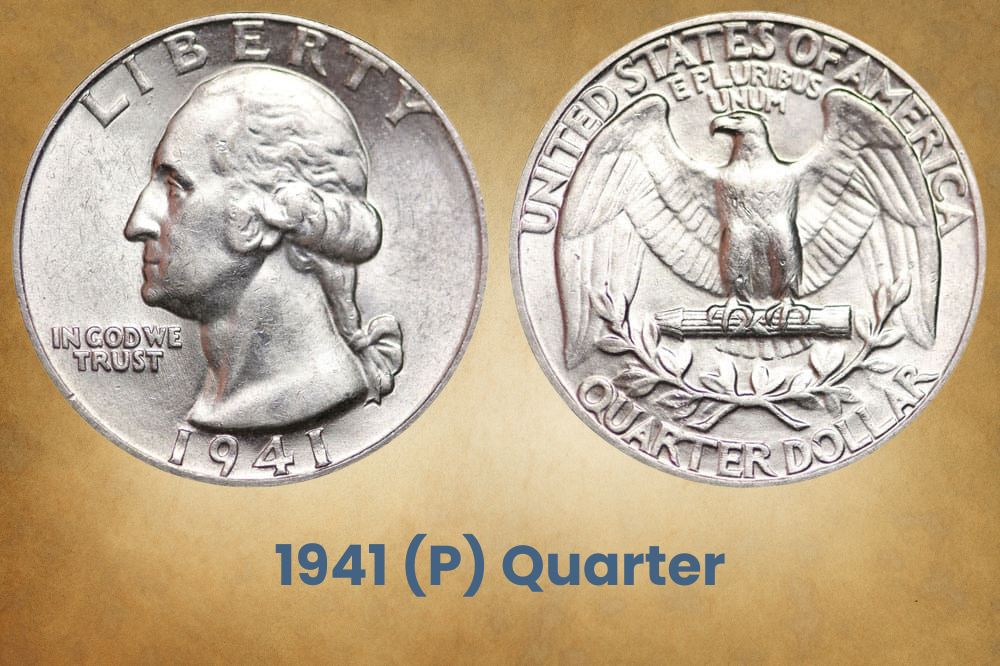
For the rest of the world, the Second World War started in 1939, and we regularly sent our allies supplies. But we didn’t officially join until 1941, and we didn’t adjust war coinage until 1942. Still, while pennies and nickels were altered for the war, quarters retained their original metal composition until 1965. Let’s dig deeper and confirm the 1941 Quarter Value.
1941 Quarter Value Chart |
|||||
| Mint Mark | Fine | Extremely Fine | Uncirculated | Mint State | Proof |
| 1941 (P) Quarter Value | $6.14 | $6.75 | $9.50 | $53 | $161 |
| 1941-S Quarter Value | $6.14 | $7.32 | $33 | $81 | No S-Proofs |
| 1941-D Quarter Value | $6.14 | $7.32 | $37 | $81 | No D-Proofs |
1941 Quarter Value Guide
Three main factors affect the value of a coin – condition, mint volume, and mint mark. These criteria combine to influence the rarity of the coin. The more samples that exist in a certain mint mark or grade, the lower the price of that specific coin. So let’s start our analysis of the 1941 Quarter value by looking at the minting location and what that does to the price point.
1941 (P) Quarter Value

In 1941, the Philadelphia Mint made 79,047,287 Quarters without mint marks, including proof coins. Given the massive availability of these coins in circulation, they’re worth $81.
1941-D Quarter Value
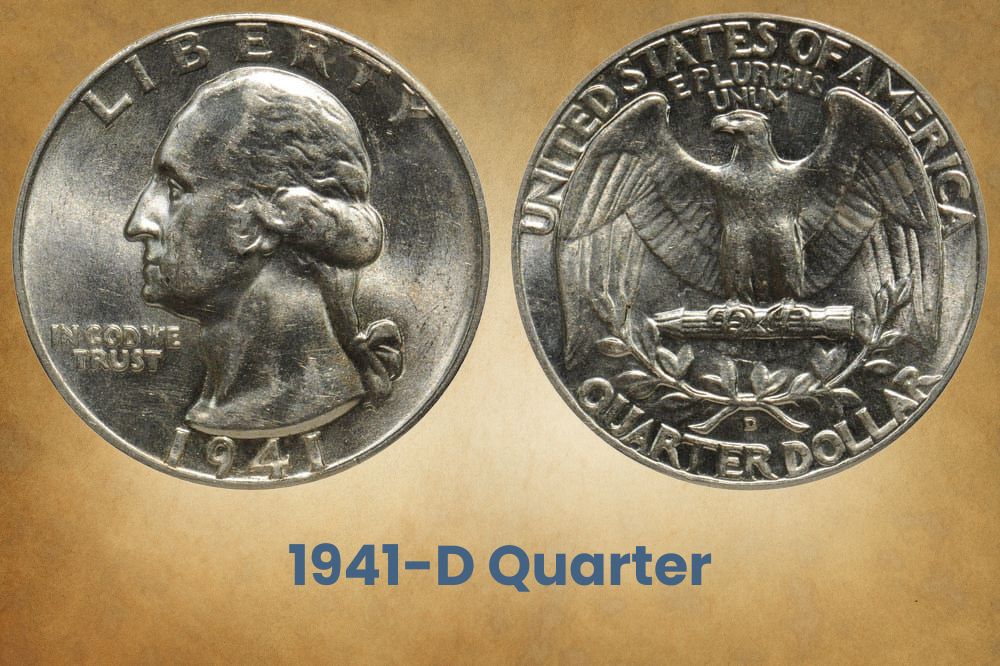
The Denver Mint made 16,714,800 Quarters in 1941, and they all had the D Mint Mark. And so far, the highest price for a 1941-D Quarter was $20,700, back in 2008. But most are $81.
Related Posts: 21 Most Valuable Quarters In Circulation
1941-S Quarter Value
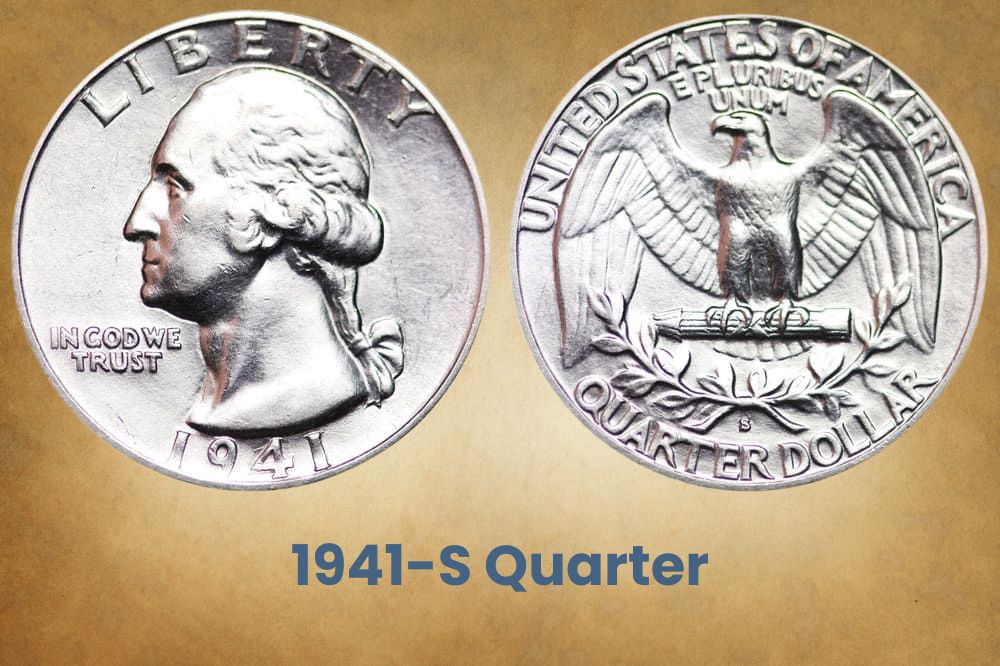
In 1941, the San Francisco Mint made 16,080,000 Quarters with the S Mint Mark. These are not proofs, though a 1941-S Quarter in MS 68 once sold for $28,750. Just four steps lower in MS 64, the price dropped to $124. The 1941-S has two types – or sizes – of mint marks, and each variety demands a different price. Large-S Quarters go as high as $30,000 in MS 68+.
1941 (P) Proof Quarter Value
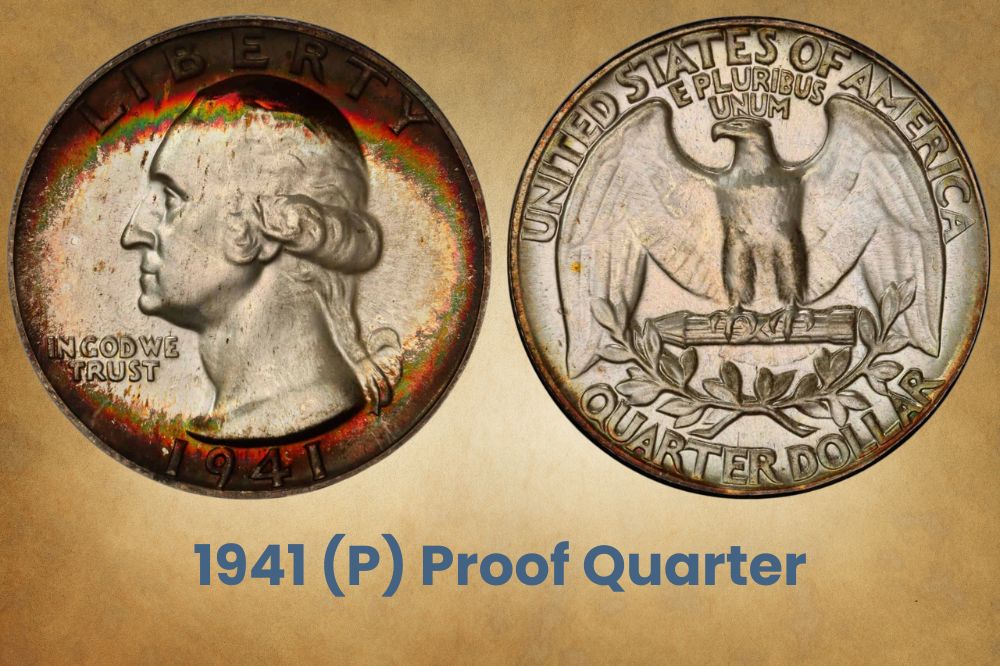
As we mentioned earlier, back in 1941, proof coins were still being made at the Philadelphia Mint. While the earliest proofs (1909 to 1917) were matte proofs, reflective proofs appeared starting in 1936 once the technology caught up. And from 1937, the ES in United States had slightly wider spacing in proofs. 1941, saw 15,287 proofs coined at the Philadelphia Mint.
Proof coins were initially for the archives and quality control, but they later became an extra source of revenue as the mint sold them to collectors. To make these coins, the mint uses special planchets that are pre-polished aka burnished blanks, plus chemically treated dies to ensure the field (i.e. the background) is polished and the device (i.e. the image) is frosted.
These additional steps mean the first 50 to 100 coins are super shiny, so we call them Deep Cameo (DCAM) or Ultra Cameo, while the next 100 or so are Cameo. But because collectors keep these coins protected from day one, most of them consistently stay in mint condition. This abundance of high-grade coins keeps proof prices low. They’re only worth $161 in PR 65.
Related Posts: 17 Most Valuable Modern Quarters Worth Money
1941 Quarter Errors
We hinted earlier that error coins can be worth a lot more than 25 cents, and according to the Cherry Picker’s Guide, the 1941 Quarter has at least 6 doubled-die errors plus the Large-S and Small-S mint mark varieties. Doubled-dies (or even tripled-dies and quadrupled-dies) happen when the die shifts between hub strikes, leading to overlapping words and numbers.
DDRs (doubled-die reverses) and DDOs (doubled-die obverses) are only worth a few bucks each. But as we said earlier, the Large-S vs Small-S debacle can launch these coin prices to over $30,000. You can find a lot of these coins in MS 66 or higher, so for real value, you’ll want an MS 66 or above. But what’s the story with S mint mark sizes, and are they rare?
Most 1941-S Quarters had an ordinary S, the same size that was in use since 1917. But a few coins had a visibly larger S that was only used in 1941, and these are the ones with premium pricing. Two varieties of this Large S are recorded – the Trumpet-Tail-S and the Serif-S, so if you bump into one in good condition, consider sending it over to PCGS or NGC for appraisal.
As a caveat, don’t get distracted by the 1941 Canadian Quarter misprint! Lots of people think 1941 is a valuable year because they’ve heard about this $35,000 coin. Many headlines will tell you it’s a 1970 Quarter Obverse on a 1941 Quarter Reverse. What they don’t tell you is the reverse was from a 1941 Canadian Quarter, hence the faint mint date near the word Dollar!
Related Posts: 16 Most Valuable Quarter Errors
History of the 1941 Quarter
When you’re trying to evaluate a 1941 Quarter, it’s important to double-check the year of the sale. After all, some 1941 Quarters in 2014 sold for $9 to $11 in AU 58 when a year or two earlier, you could hit prices of $23,000 for an MS 68. Some of these rates come from key dates and anniversaries. But we’re jumping too far ahead. Let’s begin with a bit of history.
First off, the 1941 Quarter is a Washington Quarter, made to honor George Washington, the 1st US President. This Founding Father was part of the team that wrote our constitution. He was against lots of colonial practices that were praised by the British Empire, including the habit of placing kings and queens on currency. So he ordered that this be stopped in the US.
Instead, American coins would bear the portrait of the goddess Libertas, who was used as a symbol of liberty, freedom, equality, and independence in many upcoming republics. Early Americans knew her as Lady Liberty or The Statue of Liberty, and sometimes, her image was based on a living woman selected by the artist. But we didn’t use any of our president’s faces.
This didn’t change until Congress agreed to place Abraham Lincoln on the Lincoln Cent in 1909. They did this to celebrate 100 years after his birth. Then in 1932, they followed up with the Washington Quarter to mark 200 years since the birth of this great man. They meant to mint it for only one year, but this 25c coin proved so popular that it’s still in active use today!
Understanding the Washington Quarter
After the Washington Quarter, lots of presidents appeared on circulating American coinage, with the last one being John F. Kennedy starting 1964. But the commemorative Presidential $1 series marked every deceased US President from George Washington in 2007 to George H. W. Bush in 2020. But this only applies to presidents who’ve been gone at least two years.
Most countries have a 1c, 5c, 10c, 20c, and 50c coin. So why does the US have a 25-cent piece instead? It’s because our $1 denomination was based on the Spanish Silver Dollar. This coin was known as the 8-Reale and people would physically slice it into eight wedges worth 12.5c each. Two Bits were worth 25 cents, and this was a common nickname for the early quarter.
So once we start subdividing the dollar to form our own local currency, it made sense to stick with Two Bits. Interestingly, pennies and nickels are identified as 1c and 5c at the back of the coin. But a 10c coin says Dime, our 25c coin says Quarter Dollar, and our 50c coin says Half Dollar. And while many small denominations were silver early on, they’re mostly clad now.
By 1941 though, the quarter was still a silver coin. And even as other denominations changed their composition to save nickel, copper, and silver for the war effort, the quarter stayed silver until the national coin shortage of 1965. By then, the only silver coins being struck were proofs. This gives the quarter a unique position among American circulation coins.
John Flanagan vs Laura Gardin Fraser
There’s a story that claims the first 1,500 silver coins ever made in the US came after a raid on George Washington’s cutlery cupboard. That’s like a cabinet or closet for kitchenware. The claim is that Washington took his own silver spoons and handed them over to a saw maker named John Harper. Harper then made silver half di(s)me blanks in his home cellar.
We assume Martha gave her permission, and the dies were designed by Adam Eckfeldt. The power of this myth – plus Washington’s persona – meant that when our beloved JFK was to be honored on a silver coin, Jackie O was unwilling to displace Washington. As for nickels, our 5c denomination started in base metal (copper + nickel) then went silver for the war!
This was because copper and nickel were needed for military equipment, so these 75% copper and 25% nickel coins were converted to 35% silver, 56% copper, and 9% manganese. But dimes, quarters, and half dollars stayed silver until 1965, and half dollars retained some silver until 1971. Today, only proof coins are made in silver, and that includes quarters.
Curiously, when the Washington Quarter was being considered in the early 1930s, the US Mint ran a design contest. The winner was Laura Gardin Fraser, the former student and now wife of James Earle Fraser (who was known for designing the Buffalo Nickel). But although she won, Andrew Mellon, the Treasury Secretary, preferred a coin design by John Flanagan.
This design stayed on the Washington Quarter until 2022 when Laura Gardin Fraser’s design was finally used in American Women Quarters, slated to run from 2022 until 2o25. But the Flanagan version was modified for State Quarters. Laura Gardin Fraser’s design was also used on the $5 Gold Half Eagle Washington Bullion coin. This $5 was minted in 1999.
Related Posts: Top 10 Most Valuable Bicentennial Quarters Worth Money
How to Identify the 1941 Quarter?
Before we look at the specific physical characteristics of the 1941 Quarter, let’s go over the top technical terms. The heads side of any coin is called the obverse and the tails side is called the reverse. The images are called devices and the backdrop is called the field. The blank that makes coins is called a planchet, and coins are made by striking hubs and dies.
A master hub is made using a rubber mold and an epoxy Galvano. This master hub makes a master die, which makes a working hub. The working hub makes multiple master dies, which will strike planchets to make coins. All these phases involve multiple strikes, and if the target metal shifts at any point, you could get various types of mint errors. But more on that later.
The Obverse of the 1941 Quarter
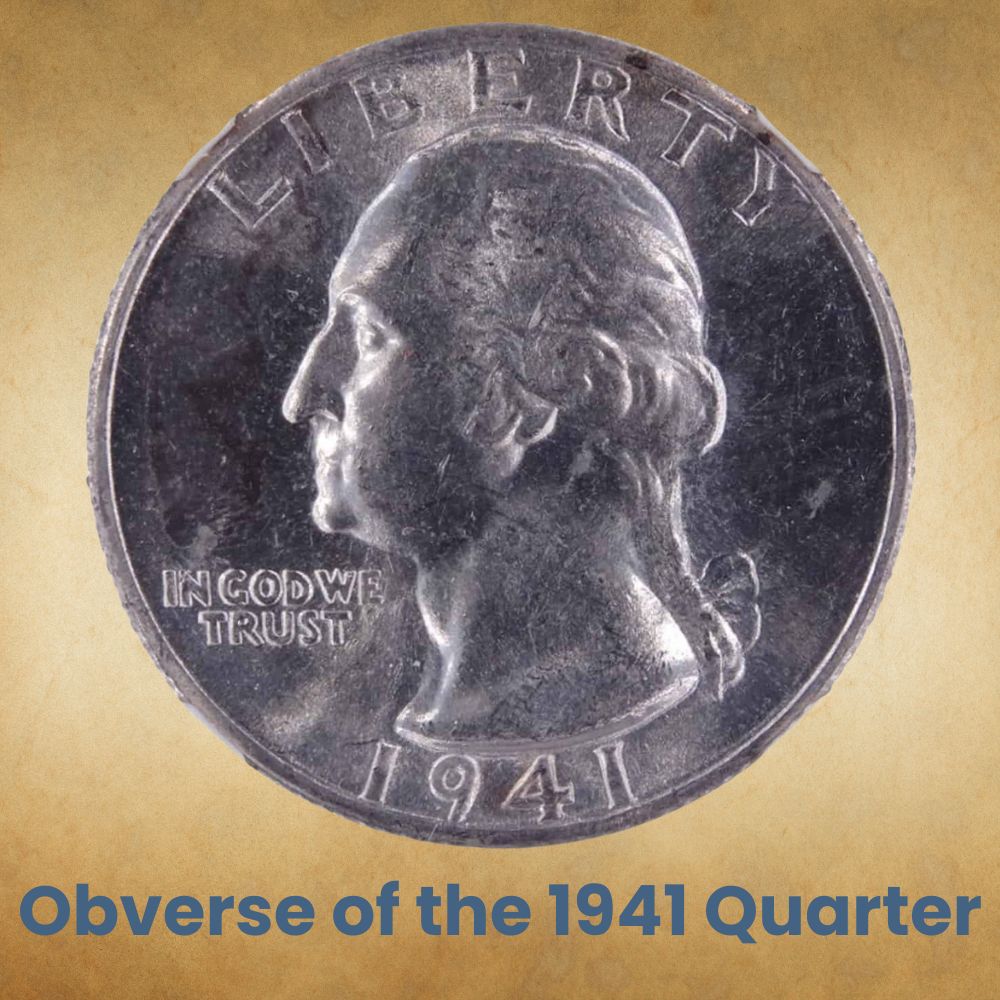
The obverse (heads side) of the 1941 Quarter had a profile of George Washington facing left. Beneath his chin, next to his Adam’s apple, was the legend In God We Trust. Another legend, Liberty, runs above his head. This designer’s initials, JF, lie at Washington’s neckline cut-off.
The Reverse of the 1941 Quarter
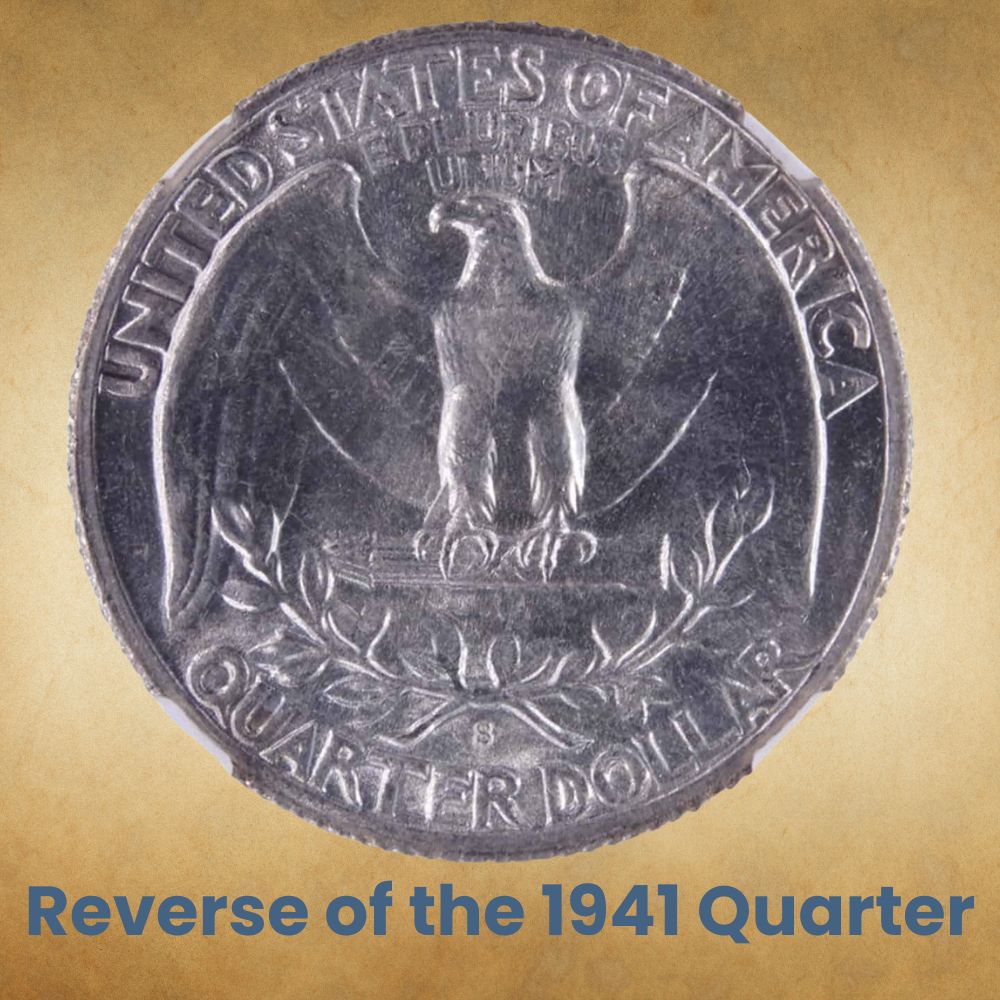
The reverse (tails side) of the 1941 Quarter is sometimes called the Eagle Reverse. It bears a bald eagle with its wings spread out, holding a bundle of 13 arrows to represent the Union’s original 13 states. Two olive branches meet between the wings, crossing at the mint mark.
At the top of the coin is the legend United States of America, with E Pluribus Unum directly below it. The bottom of the coin reads Quarter Dollar, the denomination of the coin. It’s a very tightly packed reverse with hardly any negative space, so the dies need careful hubbing.
Other Features of the 1941 Quarter
The 1941 Quarter is one of the original silver quarters, which is fitting because – as the story goes – Washington gave up his own (wife’s?) spoons so the first ever silver half di(s)mes could be minted. 1941 quarters were 90% silver and 10% copper. They measured 24.3mm across, 1.75mm thick, had 119 reeds and weighed 6.25g. Their current melt value is $3.46.
Related Posts: 20 Most Valuable State Quarters Worth Money

I have some old coins that I want to sale.